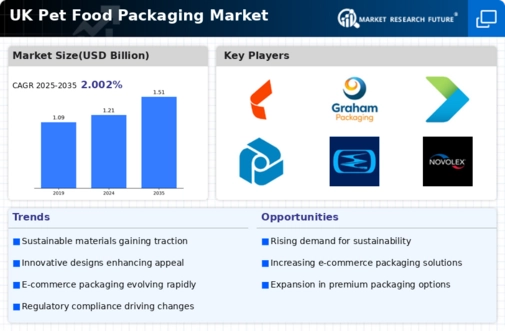The pet food-packaging market exhibits a dynamic competitive landscape, characterized by a blend of innovation and strategic maneuvers among key players. Companies such as Mars Petcare (US), Nestle Purina PetCare (US), and Hill's Pet Nutrition (US) are at the forefront, each adopting distinct operational focuses. Mars Petcare (US) emphasizes sustainability in packaging, aiming to reduce its carbon footprint, while Nestle Purina PetCare (US) is heavily investing in digital transformation to enhance customer engagement. Hill's Pet Nutrition (US) appears to be concentrating on premium product lines, catering to health-conscious pet owners. Collectively, these strategies not only enhance their market positioning but also contribute to a competitive environment that increasingly prioritizes sustainability and consumer-centric innovations.
Key business tactics within this market include localizing manufacturing and optimizing supply chains to enhance efficiency and responsiveness. The competitive structure is moderately fragmented, with several players vying for market share. However, the influence of major companies is palpable, as they set trends that smaller entities often follow. This interplay between large and small firms fosters a vibrant ecosystem where innovation can thrive, albeit under the shadow of larger competitors.
In October 2025, Mars Petcare (US) announced a partnership with a leading sustainable materials company to develop biodegradable packaging solutions. This strategic move underscores Mars' commitment to environmental responsibility and positions it favorably among eco-conscious consumers. The collaboration is likely to enhance brand loyalty and attract a demographic increasingly concerned with sustainability in their purchasing decisions.
In September 2025, Nestle Purina PetCare (US) launched an advanced AI-driven platform aimed at personalizing pet food recommendations for consumers. This initiative not only enhances customer experience but also leverages data analytics to optimize product offerings. The strategic importance of this move lies in its potential to increase market penetration by tailoring products to individual consumer needs, thereby fostering deeper connections with pet owners.
In August 2025, Hill's Pet Nutrition (US) expanded its product line to include organic and natural ingredients, responding to the growing demand for healthier pet food options. This expansion reflects a broader trend towards premiumization in the pet food sector, where consumers are willing to pay a premium for perceived quality. Such strategic actions are indicative of Hill's intent to capture a larger share of the health-conscious market segment, which is becoming increasingly lucrative.
As of November 2025, current competitive trends are heavily influenced by digitalization, sustainability, and the integration of AI technologies. Strategic alliances are becoming more prevalent, as companies recognize the value of collaboration in enhancing innovation and market reach. Looking ahead, competitive differentiation is likely to evolve from traditional price-based strategies to a focus on innovation, technological advancements, and supply chain reliability. This shift suggests that companies that prioritize these areas will be better positioned to thrive in an increasingly competitive landscape.






















Leave a Comment